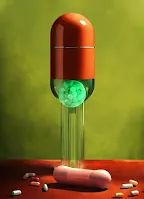OUR HEALTH AND ANTIBIOTICS
Antibiotics: Miracle Drugs or Modern Menace?
Antibiotics, often hailed as miracle drugs, revolutionized medicine in the 20th century, providing effective treatments for bacterial infections that once claimed countless lives. However, their widespread use has sparked a complex debate about their role in modern healthcare. The discovery of antibiotics is one of the most significant milestones in medical history. Sir Alexander Fleming's serendipitous finding of penicillin in 1928 marked the beginning of an era where bacterial infections could be treated with remarkable efficiency. Before antibiotics, infections from minor injuries or routine surgeries could be fatal. The advent of these drugs transformed medical practice, allowing for safe and effective treatments for a wide range of bacterial diseases. Antibiotics work by targeting essential functions within bacterial cells, such as protein synthesis or cell wall formation, effectively killing the bacteria or inhibiting their growth. This targeted action makes antibiotics highly effective against specific bacterial strains. Over time, numerous classes of antibiotics have been developed, each with distinct mechanisms of action, broadening the spectrum of treatable infections.
Advantages: The Miraculous Impact of Antibiotics
1. Life-Saving Treatments for Infections:
Antibiotics have saved countless lives by effectively treating bacterial infections such as pneumonia, tuberculosis, and sepsis.Before their introduction, these infections often resulted in high mortality rates. For instance, tuberculosis, once a leading cause of death, became a manageable condition with the advent of antibiotics like streptomycin.
2. Enabling Modern Medicine:
The success of many medical procedures relies heavily on antibiotics. Surgeries, chemotherapy, and organ transplants would be exceedingly risky without theprophylactic and therapeutic use of antibiotics. These procedures often involve high risks of infection, and antibiotics play a crucial role in preventing and treating postoperative infections.
3. Reducing the Spread of Diseases:
Antibiotics help control the spread of infectious diseases. For example, treating strep throat with antibiotics can prevent complications such as rheumatic fever and reduce transmission within communities. This has had profound public health implications, contributing to the decline of many infectious diseases.
4. Promoting Healthier Livestock:
In veterinary medicine, antibiotics have improved animal health and productivity. They are used not only to treat infectionsbut also, controversially, to promote growth and prevent diseases in livestock. This has led to more efficient food production and a more stable food supply.
5. Economic Benefits:
The development and use of antibiotics have contributed to significant economic benefits. By reducing illness and mortality, antibiotics have decreased healthcare costs and improved productivity. Healthy populations can work and contribute to economies, leading to broader societal benefits.
Disadvantages: The Modern Menace of Antibiotics
1. Antibiotic Resistance:
Perhaps the most alarming consequence of antibiotic use is the rise of antibiotic-resistant bacteria. Bacteria can evolve mechanisms to withstand the effects of antibiotics, rendering treatments less effective. The overuse and misuse ofantibiotics in human medicine and agriculture have accelerated this process, leading to 'superbugs' that are difficult or impossible to treat. For example, Methicillin-resistant Staphylococcus aureus (MRSA) is a notorious pathogen that has become resistant to multiple antibiotics, posing significant challenges in healthcare settings.
2. Impact on Microbiome Health:
Antibiotics are not selective in their action; they can disrupt the balance of beneficial bacteria in the human microbiome. This disruption can lead to various health issues,including increased susceptibility to infections, digestive problems, and possibly long-term impacts on immunity and metabolic processes. The overuse of antibiotics, especially in children, can alter the development of the gut microbiome, potentially affecting health throughout life.
3. Allergic Reactions and Side Effects:
While generally safe, antibiotics can cause adverse reactions in some individuals. Allergic reactions, ranging from mild rashes to severe anaphylaxis, can occur.Additionally, antibiotics can cause side effects such as gastrointestinal distress, liver toxicity, and interactions with other medications. These risks must be carefully managed to avoid harm to patients.
4. Environmental Impact:
Antibiotics can enter the environment through agricultural runoff, wastewater, and improper disposal. This environmental contamination can contribute to the development of resistant bacteria in nature. Aquatic ecosystems are particularly vulnerable, where antibiotics can disrupt microbial communities and potentially affect wildlife health.
5. Cost of Development and Resistance Management:
The pharmaceutical industry faces significant challenges in developing new antibiotics. The process is costly and time-consuming, with high rates of failure. Additionally, managing antibiotic resistance requires substantial investment in surveillance, stewardship programs, and research. These costs are a burden on healthcare systems and societies.
Precautions: Navigating the Responsible Use of Antibiotics
1. Prudent Prescribing Practices:
Healthcare providers must adhere to guidelines for prescribing antibiotics. This includes confirming bacterial infectionsthrough diagnostic testing and choosing the appropriate antibiotic at the correct dose and duration. Avoiding unnecessary prescriptions is crucial to reducing the development of resistance.
2. Antibiotic Stewardship Programs:
Hospitals and healthcare systems are implementing antibiotic stewardship programs to promote the appropriate use of antibiotics. These programs involve monitoring antibiotic use, providing education to healthcare providers, and implementing policies to optimize treatment outcomes while minimizing resistance.
3. Public Education and Awareness:
Educating the public about the responsible use of antibiotics is essential. Patients should understand that antibiotics are noteffective against viral infections like the common cold or flu and that completing prescribed courses is critical even if symptoms improve. Public awareness campaigns can help reduce demand for unnecessary antibiotic prescriptions.
4. Advancing Research and Development:
Investment in research to develop new antibiotics and alternative treatments is vital. This includes exploring novelcompounds, bacteriophage therapy, and antimicrobial peptides. Supporting innovation in antibiotic development and finding new ways to combat bacterial infections are crucial for staying ahead of resistant pathogens.
5. Global Cooperation and Policy Making:
Addressing antibiotic resistance requires a coordinated global effort. International organizations, governments, and the private sector must collaborate to implement policies that promote responsible antibiotic use, support research, and improve access to effective treatments. Global surveillance and data sharing are also essential for tracking resistance patterns and guiding policy decisions.
6. Environmental Safeguards:
Efforts to reduce the environmental impact of antibiotics include improving waste management practices in healthcare and agriculture, developing technologies to remove antibiotics from wastewater, and promoting sustainable farming practices that reduce reliance on antibiotics. Protecting the environment from antibiotic contamination is critical to preventing the spread of resistance.
Antibiotics have undoubtedly transformed medicine, saving countless lives and enabling medical advancements that were once unimaginable. However, their miraculous benefits come with significant risks, particularly the threat of antibiotic resistance. The challenge lies in balancing their use to maximize their life-saving potential while minimizing their adverse impacts.By navigating these complexities, we can ensure that antibiotics remain a powerful tool in our medical arsenal, safeguarding their benefits for future generations.
Have a nice day. 😊






.webp)


.webp)





Comments
Post a Comment